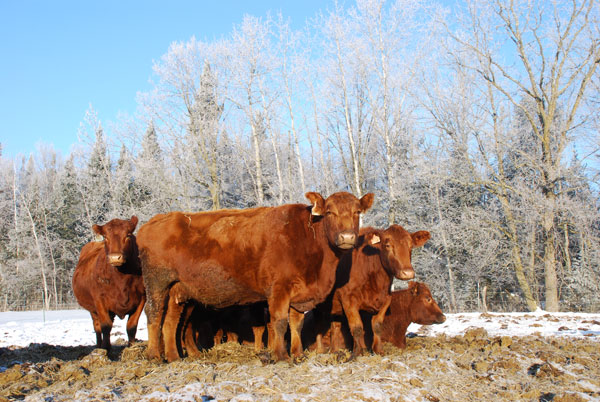3 keys to winter supplementation
There are many factors to consider when choosing a supplement, such as quality of forage, body condition score (BCS), weather and level of production.
November 22, 2016

Last Friday, we received our first blast of winter with cold and snow blanketing much of the Dakotas. With colder temperatures, the cow herd has greater energy requirements and protein supplementation is an integral part of maintaining these gestating cows’ body condition scores and growing a healthy calf.
I recently read an article by Matt Hersom and W. E. Kunkle for the University of Florida Extension on strategies for cost-effective supplementation of beef cattle. In the article, Hersom and Kunkle list three considerations for choosing the best supplement for the cow herd.
1. Energy
There are many factors to consider when choosing a supplement, such as quality of forage, body condition score (BCS), weather and level of production.
Hersom and Kunkle write, “Estimate the level of supplement needed, monitor the cattle weight and BCS change, and adjust the supplement level to meet the performance desired. The response to energy supplements will be better if a lower level of supplement is fed over a longer period time. Do not wait until the cattle are thin to start feeding supplements.
“Selecting an energy supplement that will provide TDN balanced with protein at a low cost is essential. The source of energy with the lowest cost depends on the quantities purchased, handling and storage system, processing and mixing required, feeding system, and labor available.”
2. Protein
“Results of several studies have shown a 15%–45% increase in forage consumption when forages deficient in protein relative to TDN are supplemented with protein,” they write. “A few studies have also shown a 2–5 percentage unit increase in forage digestibility. Additional levels of protein usually have no affect on forage intake and may be detrimental if the levels consumed are too high. Supplemental protein fed at 0.2–0.3 pounds daily typically costs 5–10 cents, and the cow is expected to have an increase of 2 or more pounds of TDN. This is usually more cost-effective than purchasing energy supplements.”
3. Mineral
According to the article, “Acute mineral deficiencies can result in characteristic symptoms such as the lack of pigmentation in hair associated with copper deficiency. However, many deficiencies are borderline and do not result in specific symptoms. The most likely results of a chronic mineral deficiency are ‘poor-doing’ cows that have a lower BCS, which can be caused by many different factors.
“Feed a complete mineral supplement. A complete mineral supplement containing salt, calcium, phosphorus, and trace minerals is recommended to be provided free choice. Mineral consumption varies across pastures, seasons, and cattle, but an average consumption of 2 ounces per head per day of a mineral containing 25% salt, 14%–18% calcium, 8% phosphorus, 0.4% zinc, 0.2% iron, 0.2% manganese, 0.15% copper, 0.016% iodine, 0.01% cobalt, and 0.002% selenium has been sufficient in many situations.”
To determine the best supplement for your cattle, start with evaluating body condition scores, sort off the non-lactating, heavy conditioned cows that won’t respond as well or need supplementation as much, if possible, and test your forages to gain a better understanding of what is lacking.
With tight margins due to tanked cattle prices, producers may be tempted to skip steps here and there to get by; however, supplementation through the winter months will optimize performance in the final months of gestation, which not only impacts the cow but also the future health of the calf.
The opinions of Amanda Radke are not necessarily those of beefmagazine.com or Penton Agriculture.
You May Also Like



